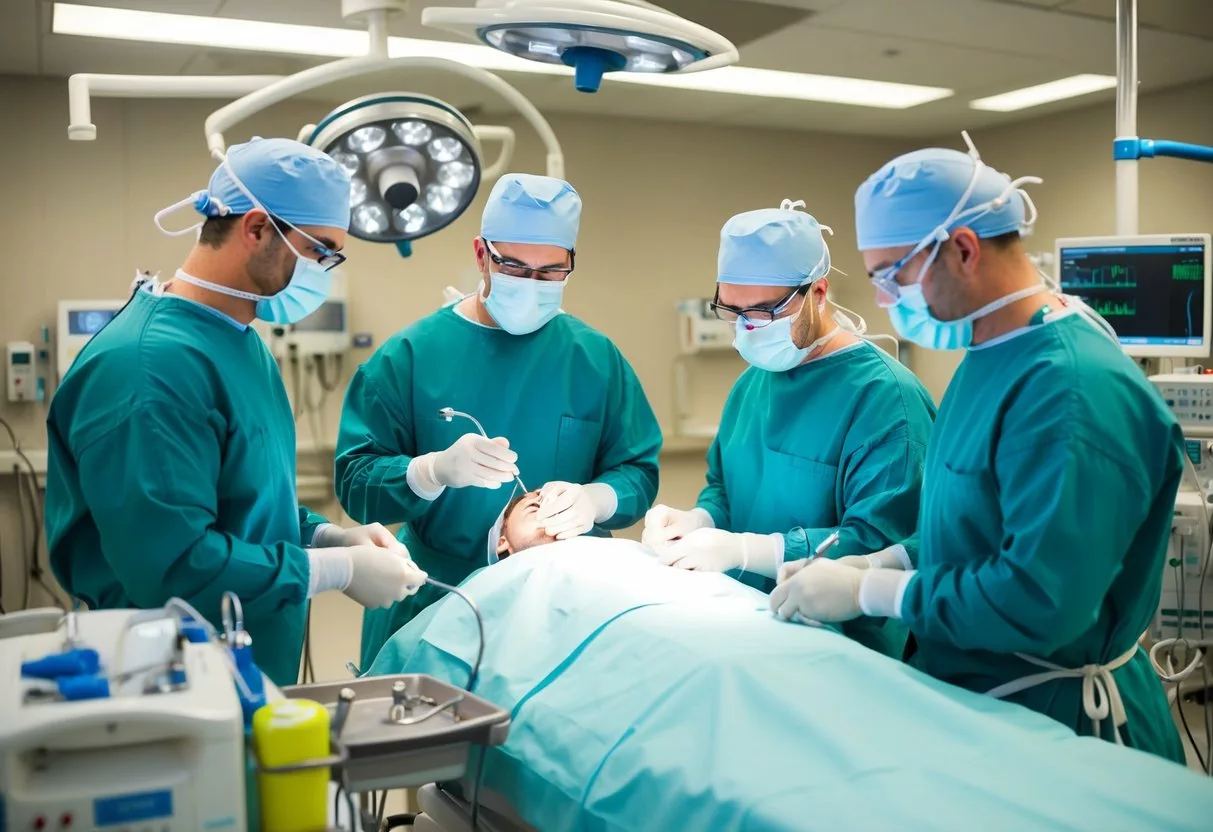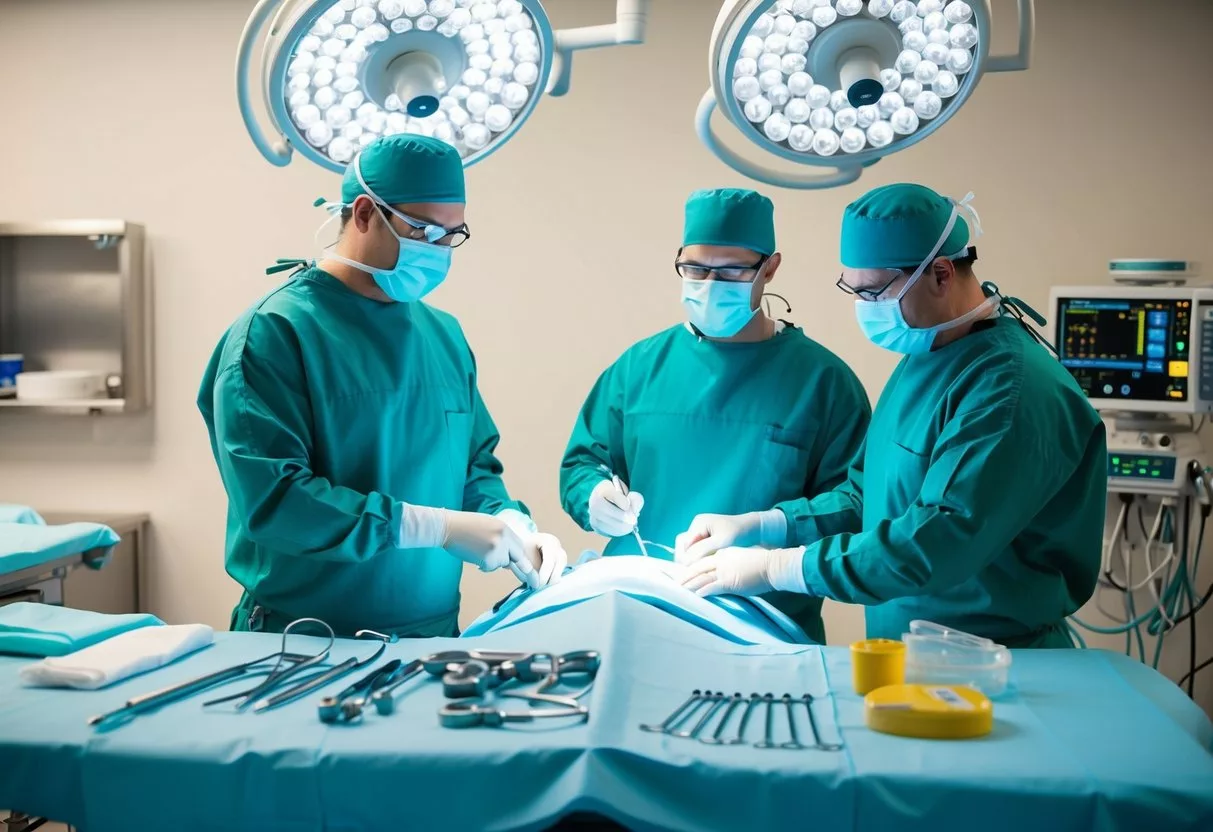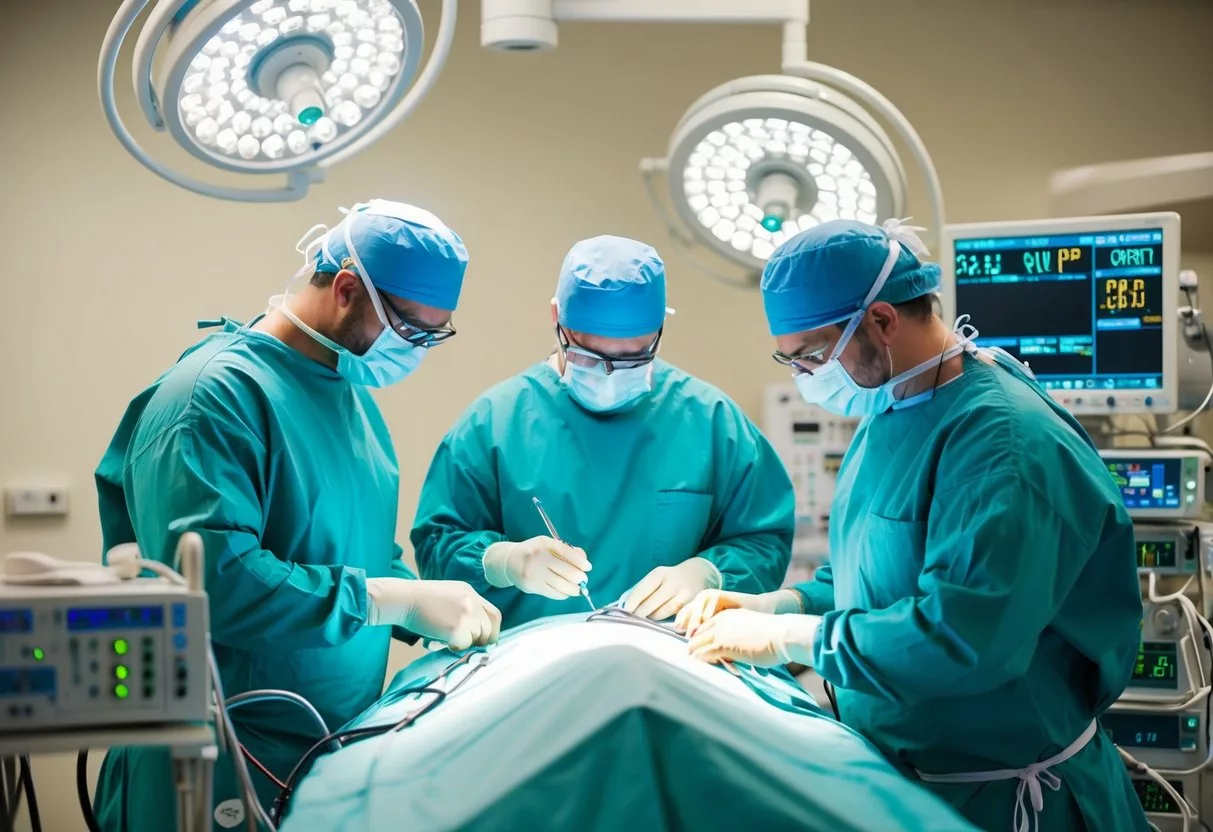Prostate removal is a major surgery that can have life-changing effects. The procedure, known as a prostatectomy, is often done to treat prostate cancer or severe enlargement of the prostate gland. After a prostatectomy, men may experience changes in urinary control, sexual function, and fertility.

There are different types of prostate removal surgeries. A radical prostatectomy removes the entire prostate gland and some surrounding tissue. This is often used to treat prostate cancer. A simple prostatectomy removes only part of the prostate and is typically done for benign prostate enlargement.
The surgery can be done through open surgery or minimally invasive methods like robotic surgery. Each type has its own risks and benefits. Recovery time and side effects can vary based on the specific procedure used and the patient’s overall health.
Prostatectomy

Prostatectomy is a surgical procedure to remove the prostate gland. It’s a common treatment for prostate cancer and some other prostate problems.
Types of Prostatectomy
There are several ways to perform a prostatectomy:
- Open radical prostatectomy
- Laparoscopic prostatectomy
- Robot-assisted prostatectomy
Open surgery involves a large cut in the lower belly. Laparoscopic surgery uses small cuts and special tools. Robot-assisted surgery is like laparoscopic, but the surgeon controls robotic arms.
Each type has its pros and cons. The choice depends on the patient’s condition and the surgeon’s skill.
Indications for Surgery
Doctors may recommend prostatectomy for:
- Prostate cancer
- Benign prostatic hyperplasia (BPH)
- Other prostate diseases
For cancer, surgery aims to remove all cancer cells. For BPH, it can ease urinary symptoms.
The decision to have surgery depends on many factors. These include the stage of cancer, overall health, and personal preferences.
Goals of Prostate Removal
The main goals of prostatectomy are:
- Remove cancer or relieve symptoms
- Preserve urinary function
- Maintain sexual function when possible
Surgeons try to spare nerves that control erections. This isn’t always possible, especially with advanced cancer.
After surgery, most men can urinate normally. Some may have temporary or long-term leakage. Sexual function may change, but treatments can help.
The prostate surrounds the urethra. Removing it can affect how men urinate and have sex. Doctors work to minimize these effects.
Pre-Surgical Considerations
Before prostate removal surgery, patients need to complete several important steps. These involve consulting with doctors, undergoing tests, and learning about potential risks. Proper preparation helps improve outcomes and reduce complications.
Consultation with Urologist
The first step is meeting with a urologist. This doctor specializes in the urinary system and male reproductive organs. During the visit, the urologist reviews the patient’s medical history and current health. They explain the surgery process and answer questions.
The urologist also checks if the patient is fit for surgery. This includes reviewing any medications and allergies. Patients may need to stop certain drugs before the procedure. The doctor gives instructions on diet and activity in the days before surgery.
Pre-Operative Tests and Assessments
Several tests are needed before prostate removal. These help ensure the patient is ready for surgery. Common pre-op tests include:
- Blood tests to check overall health
- Urine tests to look for infection
- Chest X-ray and EKG to assess heart and lung function
- Prostate-specific antigen (PSA) test
The anesthesia team also meets with the patient. They review medical history and explain the anesthesia process. Patients learn what to expect during and after surgery.
Discussing Potential Complications
Surgeons inform patients about possible risks of prostate removal. This helps patients make informed decisions. Some potential complications include:
- Urinary incontinence
- Erectile dysfunction
- Infection
- Bleeding
- Bladder neck contracture
Doctors explain how likely these issues are. They also discuss ways to manage them. Patients learn about treatments for side effects.
Some men benefit from counseling before surgery. This helps them prepare mentally and emotionally. Support groups can also be helpful.
The Prostatectomy Procedure

A prostatectomy is a surgical procedure to remove the prostate gland. It involves careful preparation, precise surgical techniques, and specialized tools. The procedure aims to treat prostate cancer or other prostate conditions effectively.
Surgical Techniques and Tools
Surgeons use different techniques for prostatectomies. The main types are open, laparoscopic, and robotic-assisted. Open surgery involves a large incision in the lower abdomen or between the scrotum and anus. Laparoscopic and robotic methods use smaller incisions.
Tools for prostatectomy include:
- Scalpels
- Retractors
- Cautery devices
- Surgical staples or sutures
- Laparoscopic instruments
- Robotic surgical system (for robotic-assisted procedures)
Robotic-assisted surgery offers enhanced precision and visualization. It uses a camera and miniature instruments controlled by the surgeon at a console.
Anesthesia and Patient Preparation
Before surgery, patients undergo thorough health assessments. An anesthesiologist administers general anesthesia, ensuring the patient is unconscious and pain-free during the operation.
Preparation steps include:
- Fasting for several hours before surgery
- Cleaning and shaving the surgical area
- Inserting an IV line for fluids and medications
- Placing a urinary catheter
Patients are positioned on the operating table, usually on their backs with legs slightly elevated. The surgical site is sterilized to prevent infection.
Step-by-Step Prostate Removal
The surgeon begins by making incisions to access the prostate. In open surgery, this is a single larger cut. Laparoscopic or robotic methods use several small incisions.
Next steps typically include:
- Separating the prostate from surrounding tissues
- Cutting the urethra above and below the prostate
- Removing the prostate gland
- Checking nearby lymph nodes for cancer spread, if necessary
- Reconnecting the bladder to the urethra
- Closing the incisions
The procedure usually takes 2-4 hours. After surgery, patients recover in a post-anesthesia care unit. The catheter remains in place for 1-2 weeks to allow for healing.
Postoperative Care

Proper care after prostate removal surgery is crucial for a smooth recovery. Patients go through distinct phases of care, starting in the hospital and continuing at home.
Immediately After Surgery
Patients wake up in the recovery room with a urinary catheter in place. This thin tube drains urine from the bladder. Pain medication helps manage discomfort. The care team checks vital signs often.
Nurses encourage deep breathing and leg exercises to prevent complications. Most men start walking short distances within 24 hours. This helps avoid blood clots and speeds healing.
Doctors watch for signs of infection or bleeding. They make sure pain is under control. Clear liquids are usually allowed soon after surgery, with solid food introduced gradually.
Hospital Recovery Period
The typical hospital stay lasts 1-3 days. During this time, the healthcare team teaches patients how to care for their catheter. They also show how to empty the urine bag.
Pain levels usually decrease each day. Oral pain medications replace IV drugs. Patients learn to do more self-care tasks as they gain strength.
Physical therapists may visit to guide safe movement. They teach exercises to do at home. Nurses explain how to care for the incision and what signs of problems to watch for.
Transition to Home Care
Before leaving the hospital, patients get instructions for home care. This includes:
- How to manage the catheter
- When to take medications
- Activity limits
- Diet tips
- Follow-up appointment details
The urinary catheter often stays in for 1-2 weeks after going home. Patients learn to clean around the catheter to prevent infection.
Gradual increases in activity are important. Short walks help recovery. But patients should avoid heavy lifting for several weeks.
Pain usually improves daily. Over-the-counter or prescription pain relievers help manage discomfort. Patients should call their doctor if pain suddenly gets worse.
Possible Short-Term Effects
Removing the prostate can lead to several temporary changes in the body. These effects usually improve over time with proper care and management.
Managing Pain and Discomfort
Pain after prostate removal is common but can be controlled. Most men feel sore for a few days to weeks. Doctors often prescribe pain medications to help.
Over-the-counter options like Tylenol or Motrin can also provide relief. It’s important to take these as directed.
Some men experience discomfort in their abdomen or rectum. This usually goes away as the body heals.
Gentle movement, like short walks, can help reduce pain and prevent blood clots.
Handling Urinary Issues
Urinary incontinence is a common short-term effect. Many men have trouble controlling their bladder after surgery.
A catheter is often used for a short time after the procedure. This helps drain urine while the body heals.
Once the catheter is removed, some men may leak urine. This typically improves over time.
Doctors may recommend exercises to strengthen pelvic muscles. These can help regain bladder control faster.
Urination might be painful at first. This usually gets better within a few weeks.
Coping with Gastrointestinal Changes
Some men experience constipation after prostate removal. This can be due to pain medications or reduced activity.
Drinking plenty of water and eating fiber-rich foods can help. Doctors may also recommend stool softeners.
Mild bloating or gas is normal. This usually resolves as the body adjusts.
Some men may have temporary changes in bowel movements. This often improves as the body heals.
It’s important to follow the doctor’s advice about diet and activity to help manage these changes.
Long-Term Outlook and Lifestyle Changes

After prostate removal, men can expect some changes to their body and daily life. These changes affect sexual function, urination, and physical activity. With time and proper care, many men adjust well to life post-surgery.
Sexual Function and Fertility
Prostate removal often leads to erectile dysfunction. This means getting or keeping an erection becomes harder. Many men can still have orgasms, but they will be dry. There’s no ejaculate because the prostate is gone.
Viagra or similar drugs may help with erections. Some men use pumps or injections instead. It’s important to talk to a doctor about options.
Fertility is affected too. Men can’t father children naturally after surgery. Sperm banking before surgery is an option for those who want kids later.
Urinary Continence and Function
Right after surgery, most men have trouble controlling their urine. This is called incontinence. It usually gets better with time and exercises.
Kegel exercises help strengthen pelvic muscles. These muscles control urine flow. Most men regain good control within a year.
Some men may need pads for a while. Others might leak a little when they cough or lift heavy things. It’s rare, but some men may need more treatment if incontinence doesn’t improve.
Physical Activity and Diet Adjustments
After healing, most men can return to their normal activities. At first, they should avoid heavy lifting and hard exercise. Walking is a good way to start moving again.
Doctors often say to wait 3-4 weeks before driving. Going back to work depends on the job. Office workers may return sooner than those with physical jobs.
A healthy diet helps recovery. Eating lots of fruits and veggies is good. Drinking plenty of water helps too. Some men find that spicy foods bother their bladder at first.
Regular check-ups are important. They help catch any problems early. With care and time, many men live full, active lives after prostate removal.
Potential Complications and Management
Prostate removal surgery can lead to several issues. Knowing the risks and how to handle them is key for a smooth recovery.
Risks Associated with Prostatectomy
Complications from prostate removal may include infection, bleeding, and urinary problems. Nerve damage can cause erectile dysfunction. Some men experience lymphedema, a swelling in the legs or groin.
Narrowing of the urethra, called a stricture, can make it hard to pee. This happens in about 5% of cases. Incontinence is also common at first but often improves over time.
Rarely, injury to nearby organs like the bowel or bladder can occur. These issues may need more surgery to fix.
Preventing and Treating Complications
Doctors take steps to lower risks during surgery. They use special techniques to protect nerves and blood vessels. After surgery, patients get medicine to prevent blood clots and infection.
For urinary issues, doctors may suggest exercises or medication. Erectile dysfunction can be treated with pills, injections, or devices.
If strictures form, a procedure to stretch the urethra can help. Severe cases may need surgery. Pelvic floor exercises can improve bladder control.
Close follow-up care is vital. Patients should report any new symptoms right away. With proper care, most complications can be managed effectively.
Follow-Up Care and Monitoring

After prostate removal surgery, patients need ongoing medical care. This includes regular check-ups, tests, and careful monitoring to ensure the best possible outcomes.
Postoperative Visits and Testing
Patients typically see their urologist within 1-2 weeks after surgery. The doctor checks the incision site and removes any stitches or staples. They also assess urine flow and bladder control.
Follow-up visits occur every 3-6 months for the first year, then annually. At these appointments, the urologist performs a physical exam and orders blood tests to check PSA levels.
PSA testing is crucial after prostate removal. In most cases, PSA should be undetectable. Any rise could signal cancer recurrence.
Understanding Pathology Results
The removed prostate is examined by a pathologist. This analysis provides important information about the cancer.
Key points in the pathology report include:
- Tumor size and location
- Gleason score (cancer aggressiveness)
- Tumor stage
- Margins (whether cancer cells are found at the edge of the removed tissue)
These results help determine if additional treatment is needed. They also guide future monitoring plans.
Long-Term Prognosis and Surveillance
Long-term outcomes after prostate removal are generally good. Many men remain cancer-free for years or even decades.
Regular PSA testing continues indefinitely. If levels rise, it may indicate cancer recurrence. Additional tests like imaging scans might be needed.
Some men may require further treatment such as radiation or hormone therapy. This depends on individual factors and how the cancer behaves over time.
Life expectancy after prostate removal is often similar to men without prostate cancer. Maintaining a healthy lifestyle and attending all follow-up appointments is important for long-term health.